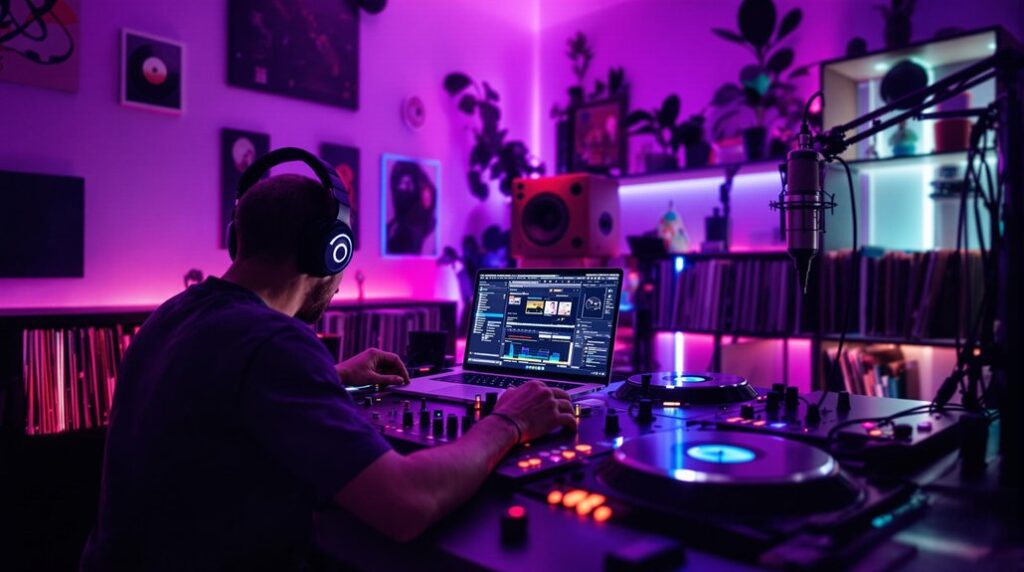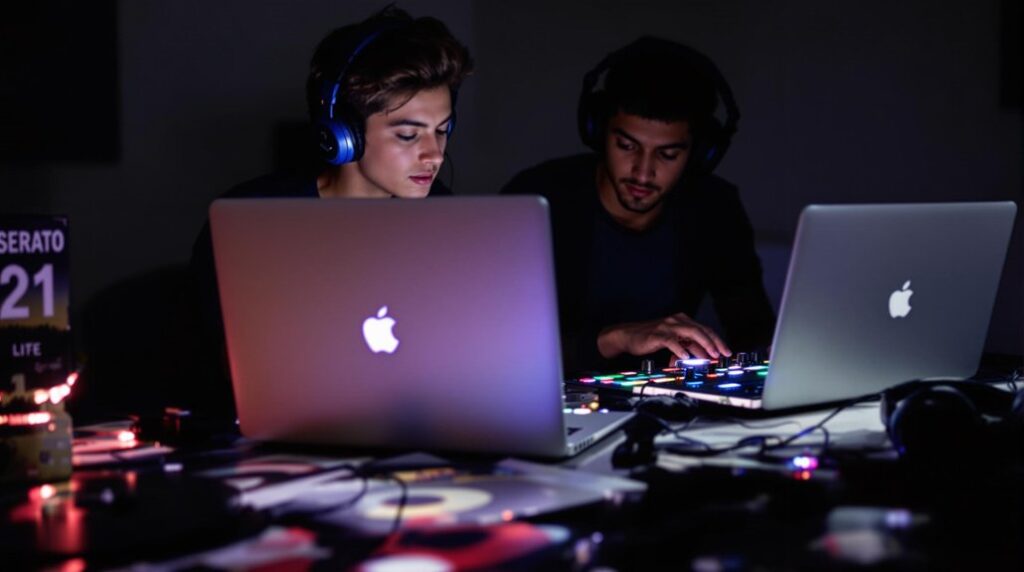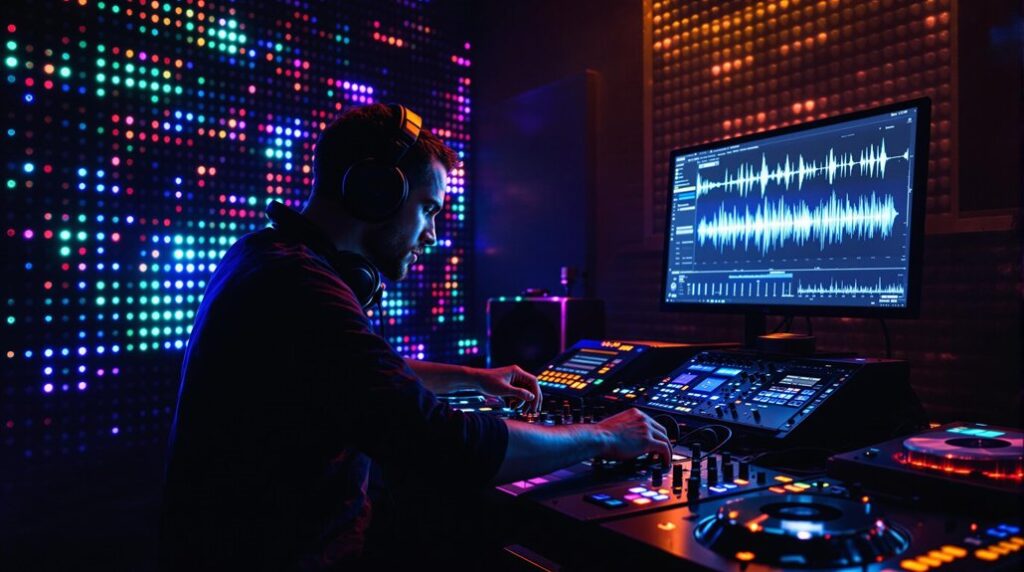Begin by understanding the basics of DJing and mastering key techniques like beatmatching. Equip yourself with a DJ controller, software like Traktor, and reliable headphones. Carefully build a varied music library, prioritizing legal ownership. Regular practice is essential, using recording for self-assessment. For your first performance, prepare extensively with diverse tracks and solid equipment knowledge. The journey to becoming a successful DJ unfolds with dedication and continuous learning. For those seeking further insights into DJing, their journey beckons with more opportunities to explore.
Key Takeaways
- Begin by investing in a DJ controller and reliable DJ software like Traktor, Serato, or rekordbox.
- Build a diverse music library with 50-100 tracks from digital marketplaces and DJ Pools.
- Practice regularly to refine mixing skills and experiment with different techniques.
- Organize your music by genre, energy level, or theme for easy access during sets.
- Record and review your mixes to identify strengths and areas for improvement.
Understanding the Basics of DJing
DJing, an art form with roots tracing back to the 1930s, has evolved considerably over the decades, becoming a cornerstone of modern music culture.
A fundamental understanding of DJing requires mastering core mixing techniques such as beatmatching and shifting between tracks. These skills are essential in delivering seamless DJ sets.
With the advent of digital DJ technology, music production has become more accessible, allowing DJs to innovate within their sets.
Building a versatile music library across various genres enhances a DJ's capability to connect with diverse audiences.
Preparation, including creating playlists and organizing tracks, is vital for optimizing performance quality.
Mastering beat matching enhances dynamics and energy in live sets and is critical for engaging the audience.
Embracing these basics sets the foundation for any aspiring DJ to explore the exciting possibilities of the craft.
Essential DJ Equipment for Beginners
For those starting their DJ journey, assembling a basic setup is both exciting and manageable with the right guidance. A DJ controller serves as the heart of this setup, integrating essential functions like decks and a mixer for seamless music control, while software options such as Traktor, Serato, and rekordbox offer intuitive interfaces for mastering the art of mixing. Equipping oneself with quality headphones and budget-friendly speakers enhances the experience, and considering a reliable audio interface can further refine sound output, ensuring even beginners can achieve professional results. It is important to consider DJ software for beginners, like Serato DJ Intro or Virtual DJ Home, as they provide user-friendly interfaces and essential functionalities to support learning and creativity.
Core Beginner Gear Essentials
Although entering the world of DJing may seem intimidating, the right equipment can make the journey smoother and more enjoyable.
At the heart of a beginner's setup is a DJ controller, which merges decks and mixer functionalities to facilitate seamless music manipulation and shifts. Coupling this with a laptop or computer equipped with DJ software such as Traktor, Serato, or rekordbox, provides a versatile platform for mixing at various skill levels.
Essential for cueing and monitoring tracks, quality headphones allow DJs to prepare upcoming songs discreetly. To project the final mix, reliable speakers are vital.
Finally, audio interfaces enhance sound quality and guarantee robust connectivity between devices, elevating a beginner's setup to a more professional level.
Budget-Friendly Equipment Options
Starting on a DJing journey doesn't have to break the bank, thanks to numerous budget-friendly equipment options available for beginners.
Essential DJ equipment includes a basic DJ controller, which serves as an affordable entry point by integrating a mixer and decks. Priced under $150, these controllers allow novices to explore mixing without a hefty investment.
A laptop or computer is vital for running DJ software like Serato or Traktor, which facilitates track organization and live performance. Good quality headphones are indispensable for cueing and monitoring, ensuring precise mixes.
Budget-friendly speakers can adequately deliver sound during practice sessions and small gigs. Investing in DJ software, even free versions, provides access to essential features, empowering beginners to effectively mix and perform.
Recommended DJ Software Choices
Choosing the right DJ software is an important step for beginners enthusiastic to explore the world of mixing and performance. Popular choices like Traktor, Serato, and rekordbox offer user-friendly interfaces and crucial features critical for digital music mixing. These platforms typically include capabilities such as beatmatching, cueing, and effects application, which are essential for smooth shifts. Beginners benefit from free versions or trial periods, enabling an exploration of features without immediate financial commitment.
| Software | Key Features | Trial Availability |
|---|---|---|
| Traktor | Beatmatching, Effects | Free Trial Available |
| Serato | Cueing, Track Organization | Free Version Available |
| rekordbox | Effects, Compatibility | Free Version Available |
Investing in DJ software is a cost-effective approach to enhance skills, with tutorials and community support readily available for newcomers.
Building Your Music Library
Building a diverse music library enables DJs to experiment with various genres, discover new techniques, and engage their audience effectively. Beginners should aim to collect music through digital marketplaces and DJ Pools, starting with at least 50-100 tracks. Legal ownership guarantees high sound quality and maintains a DJ's professional integrity. To optimize performance, one must organize their tracks by genre, energy level, or theme, ensuring easy access during gigs and facilitating smoother shifts. Regularly updating the library with original music and remixes helps establish a distinctive style, allowing DJs to connect deeper with their audience and remain relevant in an ever-evolving music scene. Utilizing music management software can streamline library management with features like advanced organization and playlist creation, making it easier to adapt to various events and moods.
Mastering Key Mixing Techniques
Mastering key mixing techniques is essential for DJs seeking to enhance their craft and captivate audiences with seamless shifts. Beatmatching serves as the foundation, requiring DJs to synchronize track tempos using the pitch/tempo slider. Mixing techniques also rely on volume faders and EQ controls, critical for balancing sound and ensuring smooth changes. Harmonic mixing, grounded in music theory, allows DJs to blend tracks in compatible keys, offering a harmonious listener experience. Regular practice is fundamental, enabling DJs to refine their skills and identify improvements. Recording and reviewing mixes is encouraged for continuous growth. Exploring dynamic energy management helps DJs create engaging sets by managing the energy flow to keep the audience captivated throughout the performance.
| Technique | Key Feature | Benefit |
|---|---|---|
| Beatmatching | Tempo synchronization | Seamless changes |
| EQ Controls | Sound and tonal balancing | Enhanced mix quality |
| Harmonic Mixing | Key compatibility | Harmonious experience |
Embracing these principles raises a DJ's performance.
Developing Your Unique DJ Style
Having honed key mixing techniques, DJs are well-positioned to explore the art of developing a unique style that sets them apart in the dynamic realm of music.
This journey involves experimenting with different genres and techniques to discover what resonates with both the DJ and their audience. A distinct sound emerges through creating original music or remixes, elevating one's presence in the crowded DJ environment.
Mastery of harmonic mixing is essential, ensuring smooth shifts between tracks and enhancing the DJ's unique flair. Engaging with the audience and adapting based on their reactions further refines a DJ's performance style.
Building a music library that reflects personal taste while considering crowd preferences solidifies a DJ's identity, creating a cohesive and memorable experience.
Understanding song structure improves mix cohesion and emotional engagement, enabling DJs to create a seamless and captivating musical journey.
Practicing and Recording Your Mixes
Regular practice is the backbone of a DJ's growth, serving as the foundation for refining mixing skills and developing a distinctive sound. Dedicated sessions enable DJs to experiment with techniques and focus on specific goals. Utilizing DJ software with built-in recording features, artists can capture their mixes for critical review. This process helps identify strengths and areas for improvement by listening from an audience's perspective. Setting specific goals, such as mastering shifts, guarantees focused progress. Organizing your music library methodically can streamline the mixing process, making it easier to craft sets. Sharing these recorded mixes on platforms like SoundCloud can build an audience and receive constructive feedback.
| Task | Benefit |
|---|---|
| Practicing | Refines mixing skills |
| Recording mixes | Provides performance review opportunities |
| Setting goals | Guarantees focused development |
This structured approach enhances a DJ's visibility and growth within the community.
Preparing for Your First DJ Performance
To guarantee a confident debut, DJs should allocate at least three days for preparation, focusing on effective strategies such as packing a diverse selection of music and organizing tracks for seamless shifts. Selecting the right equipment is essential; conducting a thorough sound check upon arrival can mitigate potential issues and enhance the performance environment. Understanding outdoor acoustics is crucial for optimizing sound quality in open spaces, as wind and natural barriers can impact sound dispersion. Crafting a versatile set that anticipates crowd dynamics and includes backup options prepares the DJ to adapt smoothly to any unexpected challenges.
Effective Preparation Strategies
When preparing for your first DJ performance, effective strategies can greatly enhance the experience and reduce stress.
Effective preparation begins with packing twice the music you anticipate needing. For a three-hour DJ set, aim for 120 tracks, allowing flexibility and adaptability. Organizing tracks into mini-sequences or pairs can streamline changes, keeping performance smooth.
Keep in mind, having a plan B is essential; it guarantees you're ready for any crowd reaction or technical hiccup. Create a checklist of everything you need, including all necessary equipment and accessories, to avoid last-minute issues.
Arriving early grants ample time for setup and sound checks, identifying potential problems. Strategically planning your set with strong openings and closings leaves a lasting impression.
Choosing the Right Equipment
After mastering effective preparation strategies, attention turns to selecting the right equipment, a cornerstone for any successful DJ performance.
A basic DJ controller, which combines decks and a mixer, serves as an excellent starting point, often available for under $150. Alongside this, a reliable laptop with DJing software like Traktor, rekordbox, or Serato is essential for mixing and organizing one's music library.
Quality DJ headphones are indispensable for cueing tracks and minimizing external noise. Speakers or studio monitors, chosen to fit budget constraints, guarantee clear audio output.
Collecting music and familiarizing oneself with these pieces of equipment builds confidence, paving the way for smoother shifts during live performances. This foundational setup empowers DJs to focus on creativity and audience engagement.
Crafting Your DJ Set
Crafting a DJ set is an art form that combines technical skill with creative intuition. For a DJ's first performance, preparation is key.
DJ Tips suggest packing at least twice the amount of music needed; for a three-hour set, 120 tracks provide ample flexibility. Organizing these tracks into mini-sequences or pairs can facilitate smoother changes and ease decision-making stress.
It's important to start with warm-up tunes, gradually engaging the audience, and save high-energy tracks for peak moments. While pre-planning the set is vital, DJs should remain adaptable, making spontaneous adjustments based on crowd reactions.
Reflecting on past gigs helps refine track selection, balancing personal favorites with crowd-pleasers. Make sure to skillfully mix tracks for a seamless and dynamic performance.
Frequently Asked Questions
How Many Songs for 1 Hour Dj Set?
For a one-hour DJ set, around 20 to 30 tracks guarantee ideal song selection. Focus on set structure, tempo matching, and genre blending to maintain audience engagement. Balance familiarity with novelty to adapt smoothly to crowd dynamics.
Is 25 Too Old to Become a DJ?
Age barriers are minimal at 25, with ample learning resources available. Aspiring DJs can explore diverse genres, select suitable equipment, and leverage networking opportunities to succeed. Dedication and curiosity are key to overcoming initial challenges.
How Many Songs Can a DJ Play in 5 Hours?
In a five-hour set, a DJ can play 60 to 100 songs. Successful song selection, set length management, tempo matching, and genre blending are essential for maintaining audience engagement, with each factor influencing the total number of tracks played.
Can You DJ With No Experience?
Yes, a novice can DJ without prior experience. By mastering DJ techniques, focusing on music selection, understanding gear setup, and practicing mixing basics and beatmatching skills, beginners can gradually develop their proficiency and confidence behind the decks.
Conclusion
Starting on the journey to become a DJ involves more than just technical skill; it requires passion, dedication, and creativity. By understanding the fundamentals, investing in essential equipment, and curating a diverse music library, aspiring DJs lay a strong foundation. Mastering mixing techniques and developing a unique style are vital for standing out. Through consistent practice and recording, confidence grows. With preparation and enthusiasm, a DJ's first performance becomes a rewarding milestone in their musical journey.




